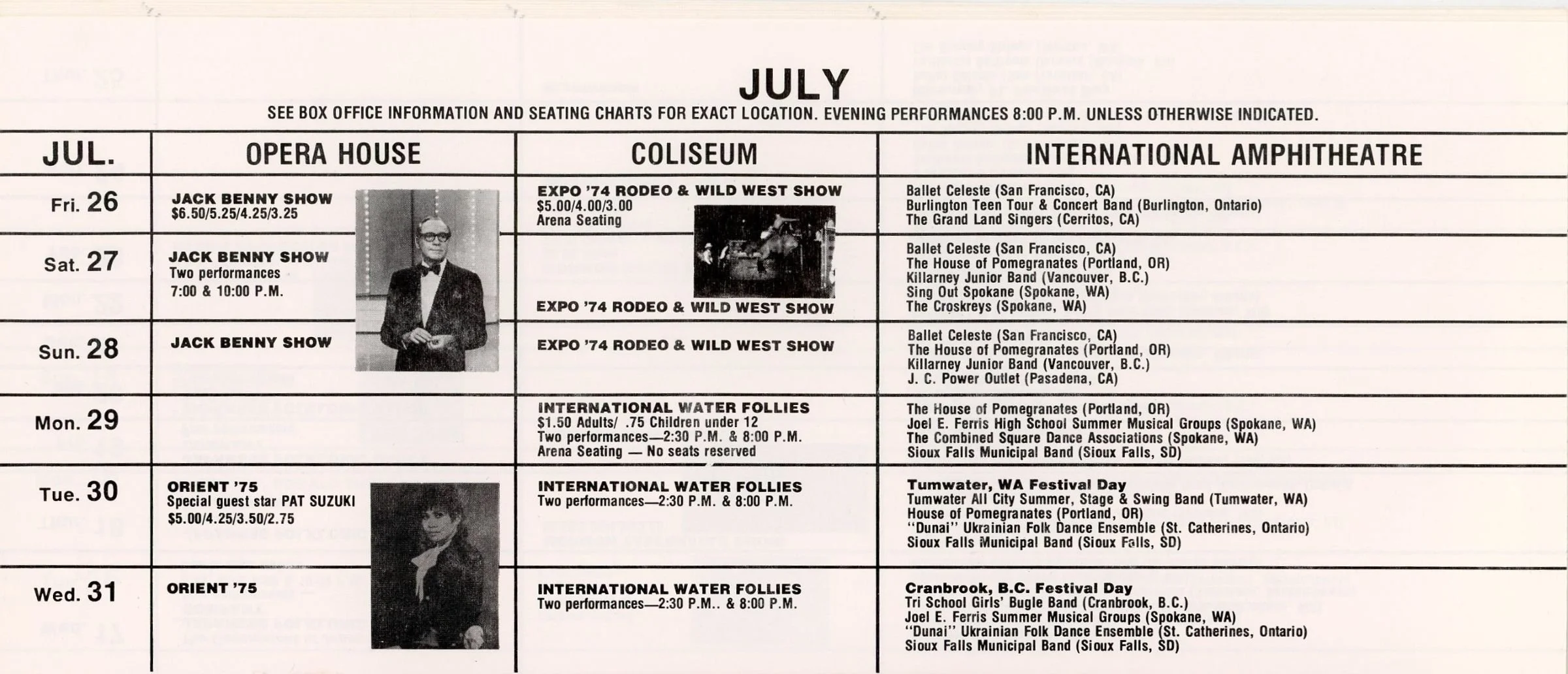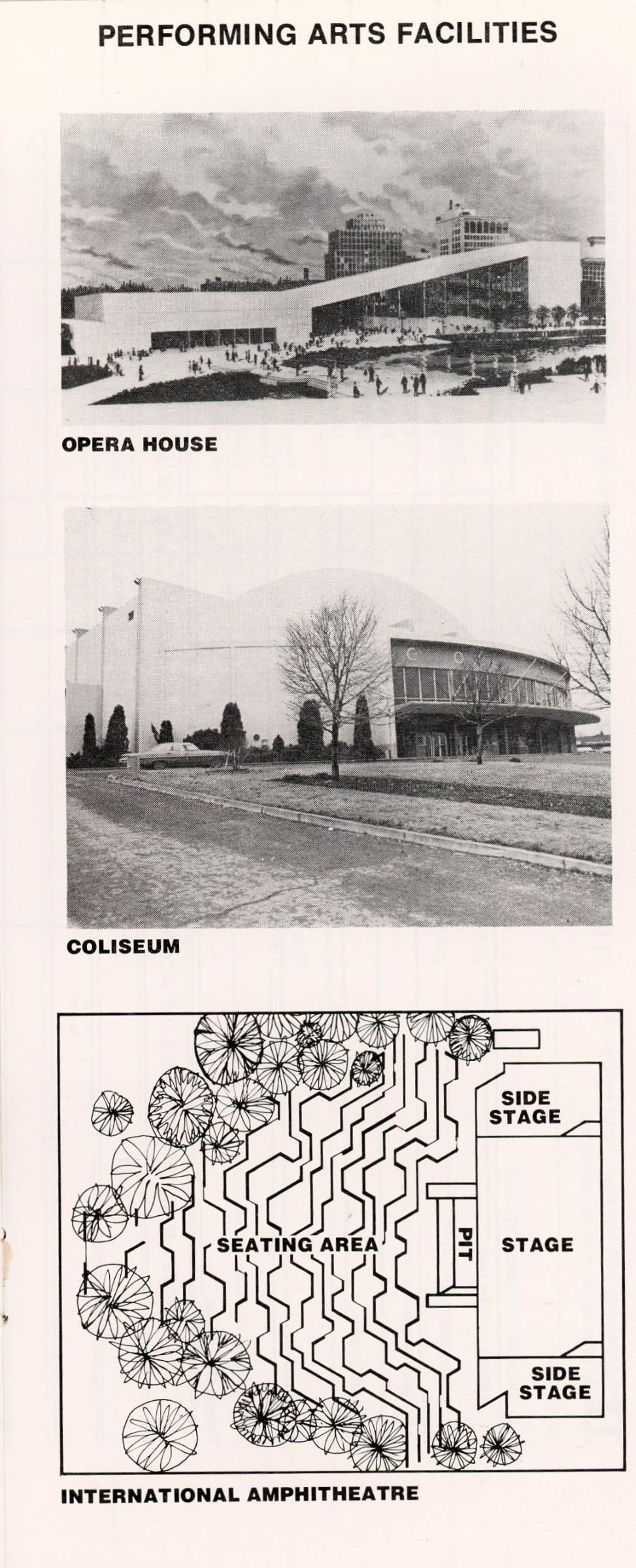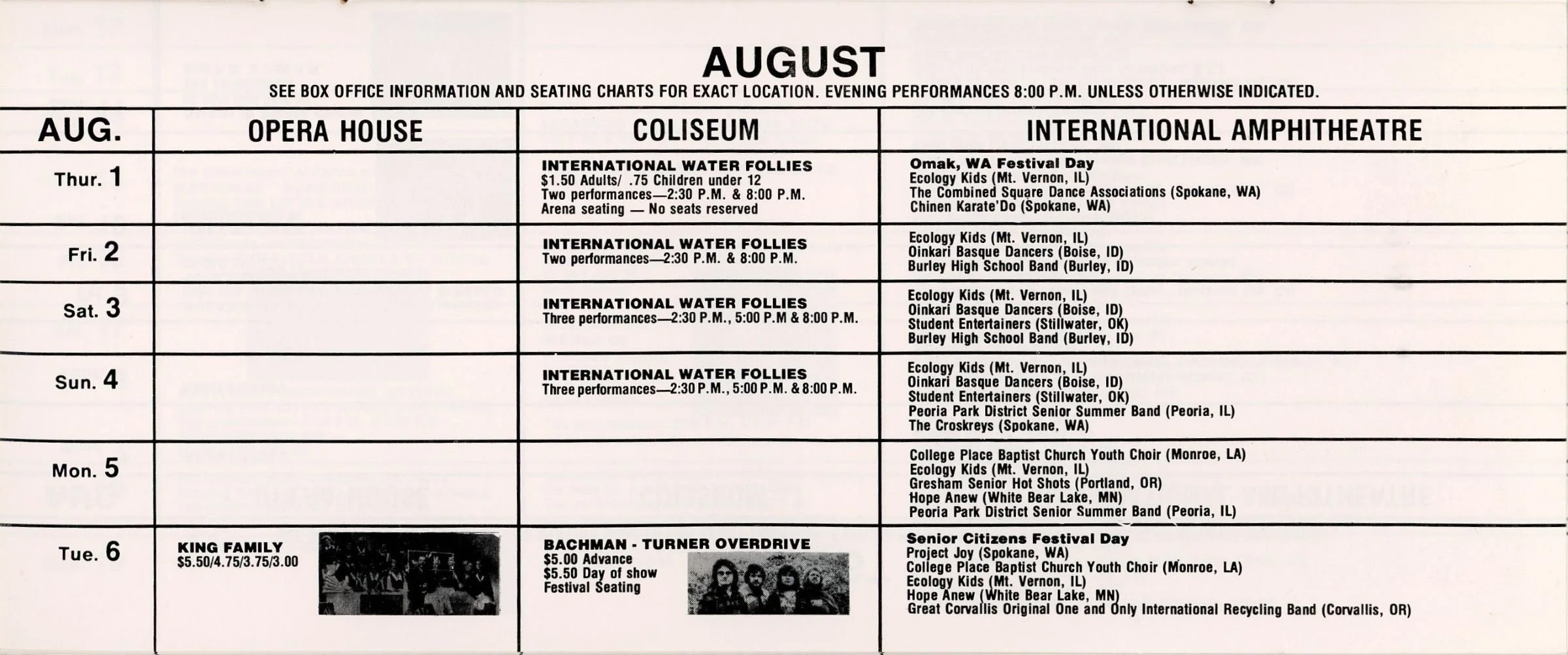Waterfalls (Hungarian Restaurant)
Waterfalls started out as a generic American-food cafeteria, but pivoted mid-fair to being a sit-down restaurant that served Hungarian food. This version of Waterfalls was far more successful. According to manager Dennis Jones, “People get footsore tramping the fair and they’d take one look in the door, see that it was a cafeteria and then go somewhere else. They want to sit down and they won’t put up with the wait of going through a cafeteria line.”
In addition to the menu options shown at right, customers could get soft drinks, coffee, milk, or beer. The Spokesman-Review also noted, “For additional atmosphere, there’s frequently an artist who will do pencil sketches of diners for no charge.”
Plaza Mexicana
Two months before opening day of Expo ‘74, fair planner King Cole had a big problem. The Mexico Council of Tourism had signed a participation contract back in August, and Expo had accommodated them accordingly. A 4200-square-foot pavilion was waiting in the shadow of the clock tower, ready to display “accomplishments of Mexican civilizations, archaeological wonders, and cultural aspects of Mexico’s environment.” (Spokesman-Review, April 2, 1974). But that pavilion was an empty shell - Mexico had not arranged for a contractor to design the interior of their pavilion, hired an architect, or announced the pavilion’s theme.
Cole traveled to Mexico City to deal with this crisis personally. When he returned in early April, he reported that the Mexico Council of Tourism had officially withdrawn from the fair, but promised that Mexico would still be represented at the fair in some form. A week later, he signed a contract with J. D. Gardea of San Antonio, Texas, to create Plaza Mexicana. This would be primarily a Mexican restaurant, but with some space reserved at the pavilion for cultural elements. Specifically, Gardea was expected to set aside 500 square feet for archaeological exhibits and at least 100 square feet for the Department of Tourism of Mexico. He was also required to produce three or more artisans to work in the merchandise area and to arrange a mariachi band to perform throughout the day.
Ultimately, the mariachis turned out to be the most challenging item on that ambitious list of requirements. Gardea initially attempted to recruit a band from Jalisco, but was unable to arrange visas for them. Instead, he hired Los Charros de Jalisco, a ten-piece mariachi band from Los Angeles. They took up their musical duties at Plaza Mexicana before the end of May. (Later that year, the leader of Los Charros de Jalisco, Pepe Martinez, provided a Spokesman-Review reporter with a great background on the origins, evolution, and unique features of mariachi music.)
When the Chronicle interviewed various young people about the fair, apparently “the Mexican pavilion was frequently described as a ‘rip-off.’” One fairgoer said, “You go in, wind around a couple of aisles, and then bang, there’s a cash register.” A survey of 77 fairgoers in October found that “No one said he enjoyed the Mormon Pavilion, the Mexican Pavilion, Burlington Northern or Waterworld.” On the other hand, the Spokane Chronicle reported: “After a modest, troubled beginning, the Plaza Mexicana has become one of the most popular places on the fair grounds.” Ray L. Peterson, the manager of Plaza Mexicana, indicated that 2500 people had visited the restaurant and bar the previous Saturday.
Based on this feedback, it seems like Plaza Mexicana was a great restaurant, just not a great national pavilion. Unfortunately, it was presented in many official materials as a national pavilion, rather than a restaurant with some extra elements. The official souvenir brochure says “Mexico highlights its famed mariachi bands as well as archaeological wonders” between talking about the USSR pavilion and the Republic of China pavilion. Similarly, the official site map lists Plaza Mexicana among the pavilions rather than the other restaurants. Plaza Mexicana was also in a building that had been designed (and scaled) for a proper national pavilion. While the Expo organizers may have hoped that this approach would help Plaza Mexicana fill in for the official Mexico Pavilion, it clearly raised expectations too high for some attendees.
The Great Northwest Midway
The Ferris Wheel at night. From Bowers’ “Expo 74 World’s Fair Spokane.”
From the Official Guidebook:
UNIVERSA - A GALAXY OF ADVENTURE
By the early light of childhood’s wonder, leaping alive on a springboard of twilight to fascinate the young-at-heart, Expo' ‘74 presents an Amusement Area to remember.
A 21-ride salute to your spirit of adventure!
Universa!
A twinkling wonderland of thrills, super-rides and challenging games of skill. And original - in the highest World’s Fair tradition.
On an L-shaped playsite edged on the south by the Fair’s boundary and on the north by the river, Universa is all aglitter with whirl-away action.
Planners traveled far to assure that Universa would be a standout attraction at this World’s Fair. Combing the imagination centers of the U.S. and Europe, they have installed twenty-one exciting rides - some of them making a first-time-anywhere debut for Expo ‘74.
In a parklike setting, you’ll enjoy a huge roller coaster, a giant ferris wheel, auto scooters, an electric speedway, large antique “drive ‘em” cars, a fun house, a banshee ride-in-the-dark, a mirror maze, the Matterhorn down-mountain ride, a waltzer, a spinaround ride, a loop ride, a breathtaking Spider ride, the Trabant - a unique new toboggan ride, the Roundup anti-gravity wheel, and the Himalaya, a Swiss winter-ride on artificial snow.
Twelve skill games - and a penny arcade - are also provided for Universa visitors, young and old.
There’ll be good, wholesome food and refreshments for you, too - at a selection of hamburger, hot dog, and popcorn palaces - together with a choice of novelty shops and an official Expo ‘74 souvenir stand.
Universa is a sure bet to take your breath away - and to borrow a share of your vacation memories to keep forever.
Postcard’s back reads: “THE GREAT NORTHWEST MIDWAY night lights give added thrills to the rides. Games, refreshments and fun for everyone.”
“Far Out” ride at rest.
“Far Out” ride in motion.
I have no idea why the midway was called “Universa” in the official souvenir program but “The Great Northwest Midway” on the postcards. Other merchandise calls it “Fun World.”
The “large antique ‘drive em’ cars” mentioned in the guidebook.
Pierre Interlude
“Pierre Interlude” was one of those unusual concessions that exclusively operated at world’s fairs. Today we might call it a “pop-up” restaurant. Owner Pierre Parker brought out his famous French onion soup every few years for fair-goers, then would return to being an antique dealer and/or gentleman of leisure. While he used his antiques to decorate his premises, restaurant patrons could also purchase the antiques to go.
Pierre had previously run a restaurant in California, but said that he found that following the fairs was more exciting. It was likely also more profitable to set up at events that attracted many hungry visitors, and likely easier to sell escargot to visitors who were interested in exploring other cultures. The menu included four main hot dishes (chicken, beef, meatballs, or shrimp) cooked in wine, with beans, mushroom, and rice on the side. Diners could also get hot or cold sandwiches. Soups were all-you-can-eat, with a side of garlic bread. Desserts were served en flambé.
Before Expo ‘74, Pierre presented his Interlude at Hemisfair in San Antonio (1968), Montreal (1967), New York (1964-1965), and Century 21 in Seattle (1962, his first fair). The Knoxville fair in 1982 appears to have been his last before retirement, and he is not mentioned in articles about the Vancouver fair in 1986.
From the Official Souvenir Guidebook:
Pierre Parker of Paris makes perhaps the most exclusive French onion soup in the world. Your only change to taste it, unless you happen to be a family friend, is to visit a world’s fair - for instance, Expo ‘74. On Nov. 4 Pierre will be out of business again until he reopens at Expo ‘75 in Okinawa the following July.
Pierre, a stocky, soft-spoken man of unmistakably Gallic charm, insists he learned the recipe for his famous soup from his mother - not in the U.S. Army, in which he served as a cook after World War II. “My whole family was in the restaurant business,” he said. “My mother did the cooking, and she taught me. My father was killed in the war, and when we move to California she opened a restaurant there, and I opened one in Laguna Beach in 1956.”
“Then in 1962 I opened a restaurant at Century 21, the Seattle World’s Fair. Since then, I work only at each world’s fair.”
And in between? ”Nossing,” Pierre says with a shrug he also must have learned from his mother. “I prepare for ze next world’s faire.”
Obviously, Pierre regards the threat of competition with something less than panic. A lesser chef might be daunted by the variety of international cuisine that will be offered visitors to the Spokane World’s Fair.
The World’s Largest Slot Machine (Reno, NV display)
The Greater Reno Chamber of Commerce presented an exhibit at Expo ‘74 in the “Travel Terrace,” apparently located between the Japanese pavilion and fair headquarters. Elements of the exhibit included an overhead map, a continuously-running film portraying the four seasons in Reno, and the world’s largest slot machine. Newspaper articles about the Reno exhibit indicate that fairgoers who play the slot machine will receive “a momento,” presumably this card that turned up in a batch of Expo merchandise. It states “The bearer of this card played ‘The World’s Largest Slot Machine’ from Reno at Expo ‘74.” The back of the card has an image of a woman in a bikini and heels, standing by the machine to demonstrate its size.













































































































































